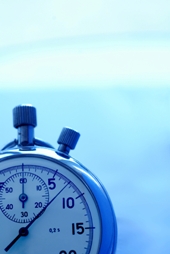|
Go Back
CerMark/TherMark Cycle Time
 The cycle time for marking with TherMark materials can vary enormously depending on a number of factors. These factors include the size of the image, the substrate being marked, the TherMark material used, the type of laser chosen to do the marking and the settings subsequently used. The cycle time for marking with TherMark materials can vary enormously depending on a number of factors. These factors include the size of the image, the substrate being marked, the TherMark material used, the type of laser chosen to do the marking and the settings subsequently used.
Substrate factors
In most cases metals will be marked with a single pass (versus the multiple passes common with a direct mark). However, factors such as wet-ability and thermal conductivity will impact how quickly a surface can be marked. For example, aluminum may require a slower speed because of its high conductivity and chrome may also be slower as it is averse to “wetting” (a process which ultimately drives bonding). Plastics tend to mark much faster due to their lower melting points.
Image size & resolution factors
It goes without saying that the larger the image, the longer the mark will take. However, changing resolution settings such as DPI and hatch spacing (on vectored images) can have a considerable impact on reducing cycle times. The trade-off to be considered is whether a reduction in time will adversely affect the image quality.
Laser type and setting factors
Laser power and speed will have a significant effect on marking time. A customer using a 25W laser will not be able to mark as quickly as a customer with a 45W laser (we do not recommend using a CO2 laser with power less than 25W). With a higher power laser it is possible to run at an increased linear speed, however this relationship between factors has limitations. Because of the time required for the bond to be created, running at a much higher power and speeds will not necessarily reduce the process time. In fact it may lead to problems in marking the substrate.
Solid state lasers with smaller spot sizes and greater energy density can sometimes mark materials more quickly than an X-Y flatbed system but are normally limited to marking smaller areas. Vectoring an image versus rastering can also speed up the process.
TherMark material factors
The supply form of the TherMark material used can also have an impact on the subsequent marking speed. As a general rule, material thickness is a key driving factor in marking speeds. Liquid inks should be sprayed thinly (<0.001”) to optimize marking speed. Products such as the LMM6018.LF paper-backed tape apply a thicker film and tend to mark at slower speeds than the liquids.
Conversely, the newly released LMM200 high speed tape offers the convenience of the tape format with an ultra thin coating thickness which optimizes speed for high volume manufacturing processes. The high speed tape can typically mark at speeds which surpass those of liquids, often twice as fast.
Because every application is different, it is difficult to estimate exact marking times. However, on projects evaluated in our applications engineering lab, we will supply you with a detailed estimate of process time.
Go Back
|